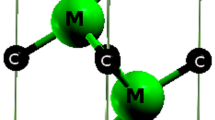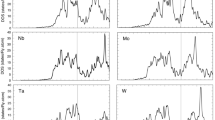Abstract.
A simple effective procedure (MNP) for finding equilibrium tetragonal and hexagonal states under pressure is described and applied. The MNP procedure finds a path to minima of the Gibbs free energy G at T=0 K (G=E+pV, E=energy per atom, p=pressure, V=volume per atom) for tetragonal and hexagonal structures by using the approximate expansion of G in linear and quadratic strains at an arbitrary initial structure to find a change in the strains which moves toward a minimum of G. Iteration automatically proceeds to a minimum within preset convergence criteria on the calculation of the minimum. Comparison is made with experimental results for the ground states of seven metallic elements in hexagonal close-packed (hcp), face- and body-centered cubic structures, and with a previous procedure for finding minima based on tracing G along the epitaxial Bain path (EBP) to a minimum; the MNP is more easily generalized than the EBP procedure to lower symmetry and more atoms in the unit cell. Comparison is also made with a molecular-dynamics program for crystal equilibrium structures under pressure and with CRYSTAL, a program for crystal equilibrium structures at zero pressure. Application of MNP to the elements Y and Cd, which have hcp ground states at zero pressure, finds minima of E at face-centered cubic (fcc) structure for both Y and Cd. Evaluation of all the elastic constants shows that fcc Y is stable, hence a metastable phase, but fcc Cd is unstable.
Similar content being viewed by others
References
P. Blaha, K. Schwarz, J. Luitz, WIEN97, Vienna University of Technology 1997. [Improved and updated UNIX version of the original copyrighted WIEN-code which was published by P. Blaha, K. Schwarz, P. Sorantin, S.B. Trickey in Comput. Phys. Commun. 59, 399 (1990)]
S.L. Qiu, F. Apostol, P.M. Marcus, J. Phys.: Condens. Matter 16, 6405 (2004)
P.M. Marcus, F. Jona, S.L. Qiu, Phys. Rev. B 66, 064111 (2002)
R.M. Wentzcovitch, J.L. Martins, G.D. Price, Phys. Rev. Lett. 70, 3947 (1993)
B. Civalleri, Ph. D’Arco, R. Orlando, V.R. Saunders, R. Dovesi, Chem. Phys. Lett. 348, 131 (2001)
W. Kohn, L.J. Sham, Phys. Rev. A 140, 1133 (1965); J.P. Perdew, S. Burke, M. Enzerhof, Phys. Rev. Lett. 77, 3865 (1996)
P. Alippi, P.M. Marcus, M. Scheffler, Phys. Rev. Lett. 77, 3892 (1997)
For both Y and Cd in the EBP calculations calculations we used RMT=2.4 bohr and a plane-wave cutoff of RKmax=9 (resulting in 1000 to 1100 plane waves), G MAX=16 bohr-1, 12000 k-points in the full Brillouin zone (828 k-points in the irreducible wedge of the Brillouin xone), convergence criterion for E of 1×10-6 Ry. In the MNP calculations we reduced the total number of k points to 4000 and the convergence criterion for E to 1×10-4 Ry
J.F. Nye Physical Properties of Crystals, Oxford Clarendon Press, London (1957), p. 142. Nye gives the stability conditions for hexagonal lattices. For tetragonal lattices the condition c66>0 must be added
WIEN97 normally calculates the Fermi energy with the tetrahedron procedure (called TETRA), which was used for the tetragonal calculations. However, calculations of the elastic constants c44 and c66 require breaking tetragonal symmetry and almost never converged. Those calculations were done with a Gaussian smearing method (called GAUSS) with a small width of 0.003
Andrew A. Quong, Amy Y. Liu, Phys. Rev. B 56, 7767 (1997)
R.M. Wentzcovitch, Phys. Rev. B 50, 10558 (1994)
F. Jona, P.M. Marcus, J. Phys.: Condens. Matter 15, 7727 (2003)
H. Bernhard Schlegel, J. Comp. Chem. 3, 214 (1982)
K. Doll, R. Dovesi, R. Orlando, Theor. Chem. Acc. 112, 394 (2004)
H. Olijnyk, A.P. Jephcoat, Solid State Commun. 115, 335 (2000) discuss anisotropy of hcp elements
B.J. Min, K.-M. Ho, Phys. Rev. B 40, 7532 (1989)
S.K. Kim, F. Jona, P.M. Marcus, J. Phys.: Condens. Matter 8, 25 (1996)[Ti]; Y. Tian, F. Jona, J. Phys.: Condens. Matter 13, 1805 (2001) [Mn]; X.Z. Ji, Y. Tian, F. Jona, Phys. Rev. B 65, 155404 (2002) [Pd]; X.Z. Ji, F. Jona, J. Phys.: Condens. Matter 14, 12451 (2002) [Mg]
W.A. Grosshans, Y.K. Vohra, W.B Holzapfel, Phys. Rev. Lett. 49, 1572 (1982); Y.K. Vohra, V. Vijayakumar, B.K. Godwal, S.K. Sikka, Phys. Rev. B 30, 6205 (1984)
W.B. Pearson, A Handbook of Lattice Spacings and Structures of Metals and Alloys, Vol. 2 (Pergamon Press, Oxford, 1967)
Author information
Authors and Affiliations
Corresponding author
Rights and permissions
About this article
Cite this article
Marcus, P., Jona, F. Automatic procedure for stable tetragonal or hexagonal structures: application to tetragonal Y and Cd. Eur. Phys. J. B 45, 39–46 (2005). https://doi.org/10.1140/epjb/e2005-00162-y
Received:
Published:
Issue Date:
DOI: https://doi.org/10.1140/epjb/e2005-00162-y




